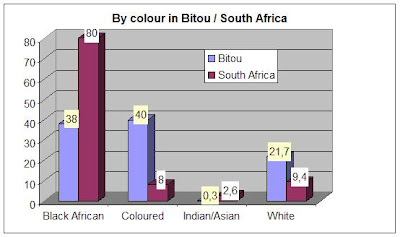 Well, here we have been living in Plettenberg Bay for two months, and I am sure hardly anyone knows where it is... Well, let's start by situating it in South Africa, at +/- 600km from Cape Town, on the Garden Route and in the Western Cape Province.
Well, here we have been living in Plettenberg Bay for two months, and I am sure hardly anyone knows where it is... Well, let's start by situating it in South Africa, at +/- 600km from Cape Town, on the Garden Route and in the Western Cape Province.Now, for all of us westerners who just love their statistics, let's see what we can find out for numbers about the Bitou municipality (of which Plett is the center):
In 2001, there were almost 30,000 people and 8,756 households residing in the municipality.
 The racial makeup of the municipality is
The racial makeup of the municipality is- Black African 37.95%, (against 80% for all of South Africa)
- Coloured 40.25%, (against 9% for all of SA)
- Indian/Asian 0.31%, (2,5% for all of SA)
- and White 21.50% (at 9.2% for all of SA)
Quite a big difference huh, so it ain't your average South African town...
In short, Bitou (like the rest of the Western Cape province) is a lot whiter and has more coloureds then the rest of South Africa. It is fairly well developed, and the center is a touristy coastal town that sometimes feels like Blankenberg. Many people from Cape Town come for the summer and stay either at a fancy hotel or have a luxurious house or villa here (it is estimated that 75% of all the house remain empty most of the year!!). But there are also 5 townships around it, where housing is a problem.
20.4% of all households are made up of individuals. The average household size is 3.33.
Ages: In the municipality the population is spread out with 26.1% under the age of 15, 18.1% from 15 to 24, 35.1% from 25 to 44, 15.1% from 45 to 64, and 5.8% who are 65 years of age or older. The median age is 27 years.

Languages : In the municipality 49.3% of residents speak Afrikaans at home, 14.1% speak English, 35.4% speak Xhosa, and the remaining speak Zulu, Sotho, or a non-official language at home.
Religion: 83.7% of residents are Christian, 12.1% have no religion, 0.2% are Muslim, 0.5% are Jewish. 3.5% have other or undetermined beliefs.
Education: 7.1% of residents aged 20 and over have received no schooling, 17.4% have had some primary school, 8.0% have completed only primary school, 32.3% have had some high school education, 24.0% have finished only high school, and 11.2% have an education higher than the high school level. Overall, 35.2% of residents have completed high school. In the 10 major schools around Plett, 6.200 kids attend schools, while only 1.300 kids go to pre-schooling (which creates a big problem for the first year in school!).
51.2% of housing units have a telephone and/or cell-phone in the dwelling, 43.5% have access to a phone nearby, and 5.3% have access that is not nearby or no access. 83.1% of households have a flush or chemical toilet. 86.7% have refuse removed by the municipality at least once a week and 1.9% have no rubbish disposal. 47.2% have running water inside their dwelling, 79.9% have running water on their property, and 84.7% have access to running water. 61.5% of households use electricity for cooking, 61.5% for heating, and 80.8% for lighting. 77.9% of households have a radio, 59.1% have a television, 13.7% own a computer, 59.4% have a refrigerator, and 36.8% have a cell-phone.
Jobs: 18.4% of the population aged 15-65 is unemployed. Of the unemployed persons, 70.4% are Black African, 26.6% are Coloured, 0.2% are Indian/Asian, and 2.8% are White. 32.1% of Black Africans are unemployed, 12.8% of Coloureds, 10.6% of Indians/Asians, and 2.5% of Whites.
The median annual income of working adults aged 15-65 is R 13 541 ($2,032). Males have a median annual income of R 14 366 ($2,155) versus R 12 051 ($1,808) for females. The median annual income by race is R 9 567 ($1,435) for Black Africans, R 12 167 ($1,826) for Coloureds, R 32 679 ($4,903) for Indians/Asians, and R 50 331 ($7,552) for Whites (five times as much as the blacks!!).
The annual income distribution in Plettenberg Bay Municipality is:

South Africa is one of the countries most affected by HIV with 5-6 million HIV infected individuals. Nearly 20% of the 15-49 year old population is infected and in parts of the country up to 40% of women of child-bearing age are infected. Overall, 12-13% of the population is infected and by 2005, this rate could reach 15%. About 2,300 new infections occur each day or over 850,000 annually. Approximately 40% of adult deaths and 29.8% of all deaths in 2000 were due to AIDS. Without effective prevention and treatment 5-7 million cumulative AIDS deaths are anticipated by 2010 (with 1.5 million deaths in 2010 alone), and there are projected to be over 1 million sick with AIDS. Recent studies predict the epidemic could cost South Africa as much as 17% in GDP growth by 2010. The extraction industries, education and health are among the sectors that will be severely affected. Over the last decade, national government leadership has not effectively addressed the epidemic although a good HIV prevention strategy was initiated.

No comments:
Post a Comment